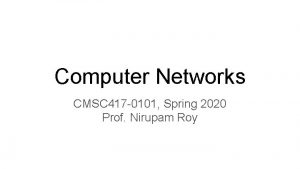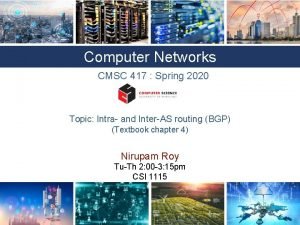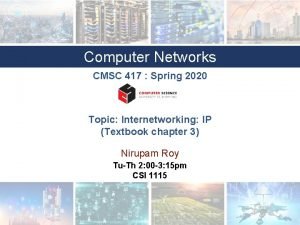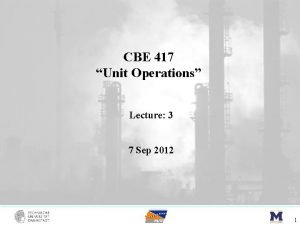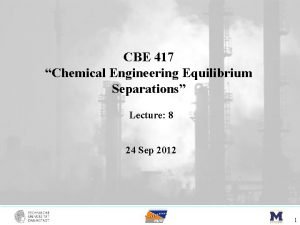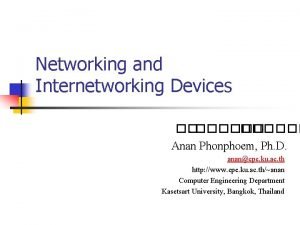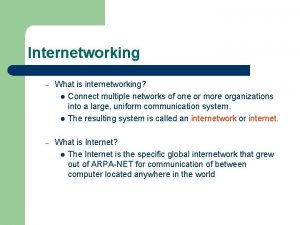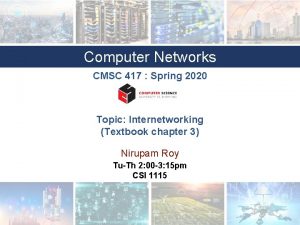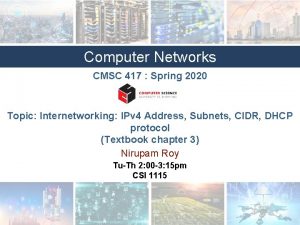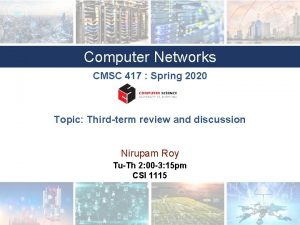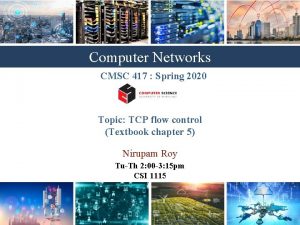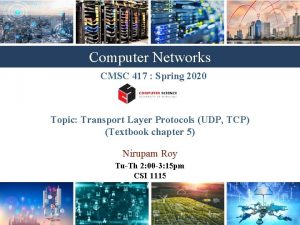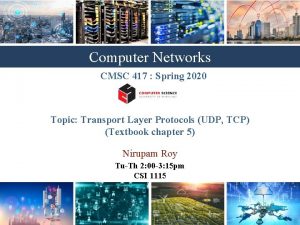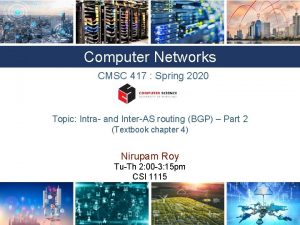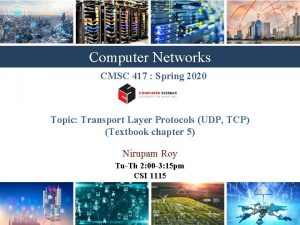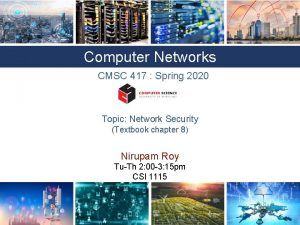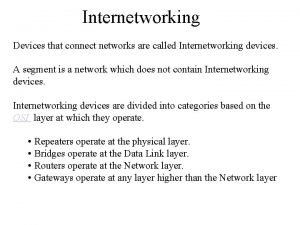Computer Networks CMSC 417 Spring 2020 Topic Internetworking


















- Slides: 18

Computer Networks CMSC 417 : Spring 2020 Topic: Internetworking: ARP, ICMP, Tunnels (Textbook chapter 3) Nirupam Roy Tu-Th 2: 00 -3: 15 pm CSI 1115

Address Resolution Protocol (ARP) 2

MAC addresses and ARP • 32 -bit IP address: • network-layer address for interface • used for layer 3 (network layer) forwarding • MAC (or LAN or physical or Ethernet) address: • function: used “locally” to get frame from one interface to another physically-connected interface (same network, in IP -addressing sense) • 48 bit MAC address (for most LANs) burned in NIC ROM, also sometimes software settable • e. g. : 1 A-2 F-BB-76 -09 -AD hexadecimal (base 16) notation (each “numeral” represents 4 bits) 3

LAN addresses and ARP each adapter on LAN has unique LAN address 1 A-2 F-BB-76 -09 -AD LAN (wired or wireless) 71 -65 -F 7 -2 B-08 -53 adapter 58 -23 -D 7 -FA-20 -B 0 0 C-C 4 -11 -6 F-E 3 -98 4

LAN addresses (more) • MAC address allocation administered by IEEE • manufacturer buys portion of MAC address space (to assure uniqueness) • analogy: • MAC address: like Social Security Number • IP address: like postal address • MAC flat address ➜ portability • can move LAN card from one LAN to another • IP hierarchical address not portable • address depends on IP subnet to which node is attached 5

ARP: address resolution protocol Question: how to determine interface’s MAC address, knowing its IP address? 137. 196. 7. 78 1 A-2 F-BB-76 -09 -AD 137. 196. 7. 23 137. 196. 7. 14 LAN 71 -65 -F 7 -2 B-08 -53 58 -23 -D 7 -FA-20 -B 0 ARP table: each IP node (host, router) on LAN has table • IP/MAC address mappings for some LAN nodes: < IP address; MAC address; TTL> • TTL (Time To Live): time after which address mapping will be forgotten (typically 20 min) 0 C-C 4 -11 -6 F-E 3 -98 137. 196. 7. 88 6

ARP protocol: same LAN 1. A wants to send datagram to B • B’s MAC address not in A’s ARP table. 2. A broadcasts ARP query packet, containing B's IP address • destination MAC address = FF-FF-FF-FF • all nodes on LAN receive ARP query 3. B receives ARP packet, replies to A with its (B's) MAC address • frame sent to A’s MAC address (unicast) 4. A caches (saves) IP-to-MAC address pair in its ARP table until information becomes old (times out) • soft state: information that times out (goes away) unless refreshed 5. ARP is “plug-and-play”: • nodes create their ARP tables without intervention from net administrator 7

Address Translation Protocol (ARP) • Map IP addresses into physical addresses • destination host • next hop router • Techniques • encode physical address in host part of IP address • table-based • ARP (Address Resolution Protocol) • • • table of IP to physical address bindings broadcast request if IP address not in table target machine responds with its physical address table entries are discarded if not refreshed Query message include the physical address of the sending host. Why?

ARP Packet Format • • • Hardware. Type: type of physical network (e. g. , Ethernet) Protocol. Type: type of higher layer protocol (e. g. , IP) HLEN & PLEN: length of physical and protocol addresses Operation: request or response Source/Target Physical/Protocol addresses

Internet Control Message Protocol (ICMP) 10

Internet Control Message Protocol (ICMP) • Defines a collection of error messages that are sent back to the source host whenever a router or host is unable to process an IP datagram successfully • • Destination host unreachable due to link /node failure Reassembly process failed TTL had reached 0 (so datagrams don't cycle forever) IP header checksum failed • ICMP-Redirect • From router to a source host • With a better route information

ICMP message types

Traceroute : An unintuitive application using ICMP

Traceroute : An unintuitive application

Virtual Networks and Tunnels 15


17

Why do we need virtual networks or tunnels? 1. Security 2. Special capabilities between routers (e. g. , multicast) 3. Supporting heterogeneity Disadvantages: 1. Increases packet length a) Wastage of bandwidth b) More processing c) Fragmentation 2. Increases management cost 18
 Cmsc417
Cmsc417 Cmsc 417
Cmsc 417 Cmsc 417
Cmsc 417 Internetwork
Internetwork Virtual circuit tables
Virtual circuit tables Backbone networks in computer networks
Backbone networks in computer networks Southwest airlines route map
Southwest airlines route map Joanna savarese
Joanna savarese Seminole transportation
Seminole transportation Ece 417
Ece 417 Unit operations
Unit operations Campaign_id:417
Campaign_id:417 Ece 417
Ece 417 Material balance
Material balance Octax
Octax Kim ki duk summer fall winter spring
Kim ki duk summer fall winter spring Spring autumn fall
Spring autumn fall Networking and internetworking devices
Networking and internetworking devices L connect 2
L connect 2
